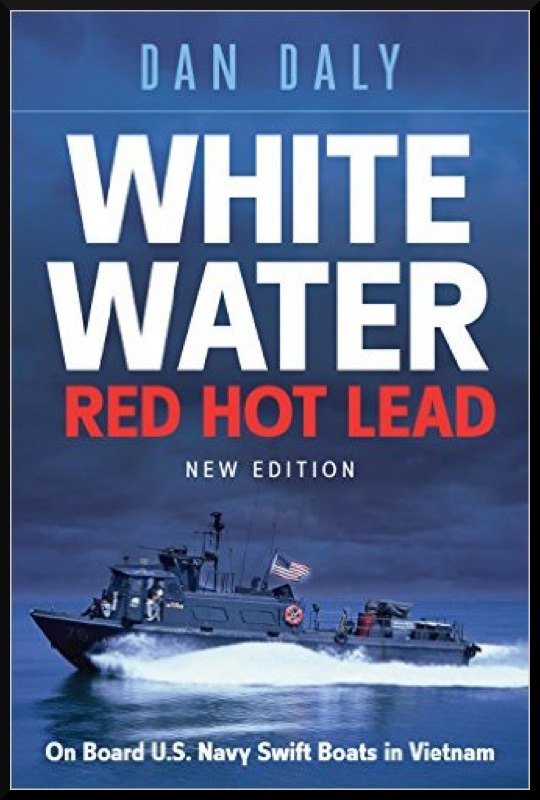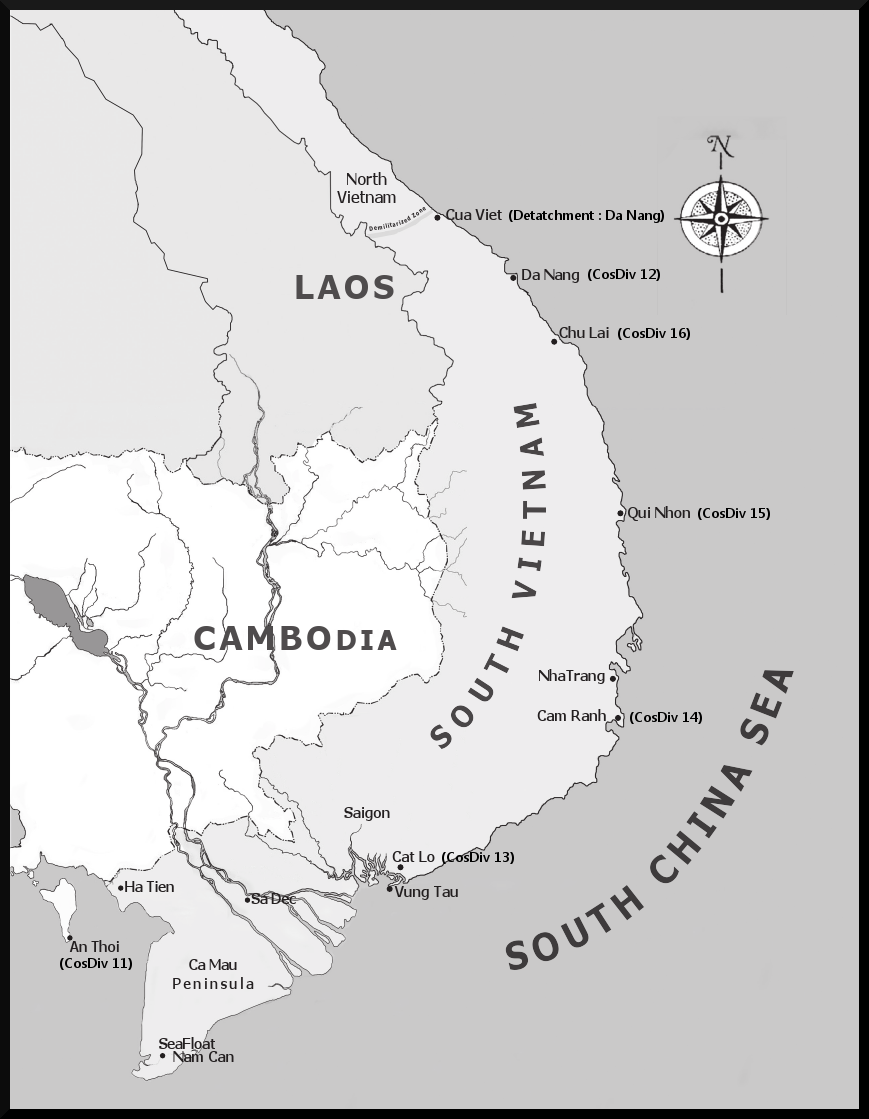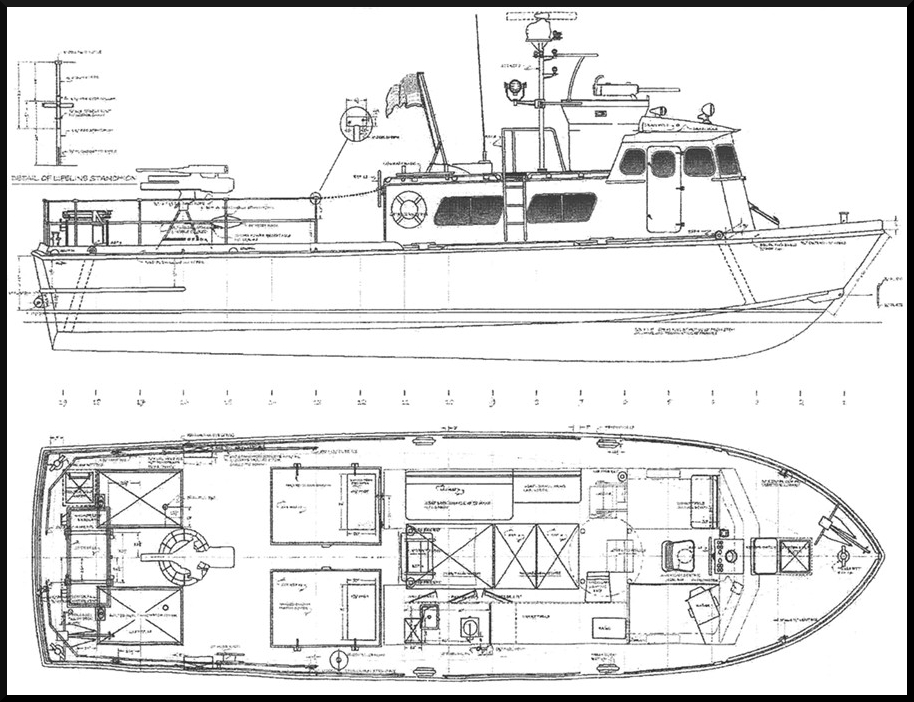
White Water, Red Hot Lead is a story about U.S. Navy Swift Boats in Vietnam in 1967 and 1968. It is an engaging and fast-paced nonfiction story that switches gears between character development intertwined with the rawness of combat, the vagaries of the landscape, with equal measures of romance and humor, all emotionally demanding, yet accurate.
The book is written by Dan Daly, a Vietnam combat veteran who was the Officer-in-Charge of PCF 76. He shares his firsthand experiences and those of his shipmates during a twelve-month tour in Vietnam. The backbone of the story is the development of the author’s all-volunteer crew, a group of young men thrown together, who would ultimately rely on each other for survival. It begins with boat and SERE (Survival Evasion Resistance and Escape) training in Coronado, California and progresses through twelve months of combat patrols. The stories of these young men encompasses lightning firefights, brutalizing weather, a touch of romance, humor and most importantly, how this inexperienced and desperate group of young men would meld into a combat team – a team that created unbreakable bonds for life.
This nonfiction story is not a broad-based history of the Vietnam conflict; it is the story of young men from across the United States who volunteered to serve their country in a type of duty that had not been seen since the PT boats of World War II.
In Vietnam, those in Swift Boats experienced naval combat in the closest confines imaginable, where the enemy was hidden behind a passing sand dune or a single sniper could be concealed in an onshore bunker, mines might be submerged at every turn and fork in the river. The enemy was not over the horizon or miles away; he was all around you, right in front of you at the next bend in the river hiding waiting while your fifty- foot Swift Boat worked its way upriver. Just the clanging noise from the metal exhaust flaps could bring on a volley of enemy machine gun or rocket fire. In many cases, upriver became so narrow there was barely room to maneuver or cut around. The only way out might be straight into a deadly ambush.
The average Swift Boat skipper was twenty four years old and enlisted crewmembers averaged about the same. A routine day could start with sunshine and calm seas, switch instantly to deadly combat, be torn apart by a terrifying storm and end with a well-deserved beer back at the base.
These stories make you part of the Swift Boat crew. You’re at the helm doing 30 kts with your left hand locked on the throttles. Firing the .50 caliber machine gun is now your responsibility. Your eyes ache and your brain is dizzy from searching the shoreline with binoculars. Wind is up, you’re 90 miles from base and the horizontal monsoon rain has just returned. It suddenly dawns on you that the enemy is hidden on shore just 100 yards away and he intends to kill you. At days end, you and your shipmates are flat ass tired but you’re glad to be alive, if only to fight another day.
Map & Mission

Image Courtesy of The Maritime Museum of San Diego
Approximately 3,500 officers and enlisted men served on board 130 Swift Boats over a five-year period from 1965 to 1970. A crew was composed
of one officer and five enlisted men and the normal volunteer tour of duty in country was 12 months. The boats patrolled out of six bases located along the coast of South Vietnam from the Demilitarized Zone (DMZ) north of Da Nang, south to Phu Quoc Island near the Cambodian border.
The original Swift Boat mission was to intercept and stop the transport of enemy troops and weapons traveling along the coast of South Vietnam as well as those transiting south from North Vietnam or China. This mission expanded significantly in the early years as gunfire support was provided on a regular basis for small independent operations of the U.S. Marine Corps, especially in the northern patrol areas. In the southern patrol areas, Swift Boat teams conducted operations on a regular basis up into the rivers of South Vietnam with the objective of denying the use of these waterways to the enemy.
The Swift Boats program lost 51 men and eight boats in combat operations. Two boats currently remain as memorials: PCF 1 in the Washington Navy Yard and PCF 104 at Naval Amphibious Base Coronado in Coronado, CA.
Specs:
Manufacturer: Sewart Seacraft, Berwick, Louisiana
Crew: One officer and five enlisted
Length: 50 feet
Speed: 30 kts, on a good day.
Engines: Two (2) General Motors Detroit Diesel 12V71 “N” rated at 480 hp each

Armament: One (1) twin .50caliber Browning machine guns manually operated, each capable of firing 450 to 550 rounds per minute. Ammo cans at the mount held up to 600 belted rounds. On board, 20 to 25,000 rounds were carried in the main cabin magazines. Maximum range was 7000 yards, effective range 2000 yards.
One (1) 81 mm Mark 2 trigger-fired mortar located below one (1) single.50caliber Browning machine gun. The range of the 81mm mortar was 4000 yards elevated and 1000 yards direct trigger-fired. These weapons were located together on a fixed tripod on the after deck. Mortar ammunition carried on board in a transom mounted locker was approximately 100 rounds composed of High Explosive, White Phosphorus and Illumination.
Boat Armor: None
An Excerpt from Chapter 1:
We were close in, no more than 100 yards off the beach, less than the length of a football field. We were eyeball-to-eyeball with the enemy. This was no standoff gun battle and unfortunately the bad guys had some cover while we were on the boat out in the open. The constant clattering from our three .50 caliber machine guns was damn near deafening, even without being combined with a similar racket coming from the other Swift Boat a short fifty yards ahead. Just behind me, the spent brass cartridges from the fired rounds jumped up out of the after gun’s breach then clanged onto the deck where they rattled and rolled, scattering underfoot surrounding the gun mount.
Driving at the after steering station, I had a clear view of the shoreline to port. My right hand was locked onto the big steering wheel and my left hand had a death grip on the throttles. I didn’t have a gun and I wasn’t shooting at the enemy; my job was to drive and try to think our way out of this bucket of shit. It was easy to see that the rounds from our boat were tearing up the top ridge of the sand dune lifting grass and dust into a swirling blanket ten feet in the air. The other Swift Boat had targeted the jungle right behind the dunes and its guns were making chopped coleslaw out of the dark green foliage.
Suddenly, out of the corner of my eye, I saw what appeared to be small puffs of smoke astern of us about thirty yards rising from the beach leading down to the water. In seconds, I recognized that these puffs of smoke were in fact the rounds from another enemy machine gun hitting the soft sand. This was the classic ambush, they had waited for both boats to engage their first firing position and now had opened fire on us, the second boat from their second position in a cross fire. The slugs rapidly continued their deadly march out across the water, marking each step with their foot-high splashes. In the next moment, the slugs started hitting amidships on our boat, each one making a high pitch squeal as they twisted and penetrated the thin quarter-inch aluminum hull. Swift Boats had no protection of armor plating, just their return fire and speed.
This enemy gunner was good; despite his constant firing, he controlled the climb of his machine gun as he swept forward to the main cabin, knocking out both our sliding windows. Fortunately, they were held in place by overlapping strips of tape that prevented razor-like shards of glass from filling the cabin. Then it occurred to me; his target was not the cabin or the windows but me! He had calculated that our boat would move forward across his line of fire and was leading the target with his weapon. Fortunately for us, he had misjudged our speed, but I guessed he would rapidly correct his aim, moving back to the steering position where I was standing. In response, I jammed the throttles full forward while I spun the large wheel hard to the right. I had no intention of being at that location.
As our big diesels roared to life and the bow of the boat started to lift, our gunner at the after mount spread his legs apart and planted both feet solidly on the deck. In one motion, he swung his big .50 caliber hard to the left following the enemy rounds back up the beach to the sniper’s location. Now, there were two players in this deadly poker game. No question, we were out in the open, fully exposed, but our hand held the higher card‒ the big .50 caliber machine gun with its belt of 400 rounds.
Please contact us with any questions or comments regarding your order at author@whitewaterredhotlead.com.








